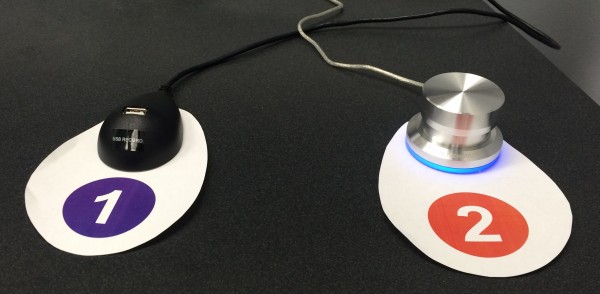What do classrooms and workplaces today now have in common?
Gamification.
While the lure of games has been around forever, its use as a tool of engagement only began to gain traction seven years ago. Since then, it has transformed into a buzzword for the classrooms and workplaces of the future. But how much do we really know about gamification and how important is it for educators today?
So keen is the interest in the topic that last month, Cecile-Anne Sison from the Media and Design Studio, Susanna Calkins from the Searle Center, and Kelly Roark of Northwestern IT held a workshop for interested faculty on how to engage students through gamification. Participants were invited to create their own fun avatar and award stars based on different parameters as introducing themselves to others or asking insightful questions. The workshop spoke to the benefits of gamification, design processes and strategies, and examples of successful gamification in education.
 Gamification, a term coined by British computer programmer Nick Pelling in 2003, is the process of integrating game-like elements in a non-game setting so as to encourage participation. It can include a variety of elements common to gaming psyche such as:
Gamification, a term coined by British computer programmer Nick Pelling in 2003, is the process of integrating game-like elements in a non-game setting so as to encourage participation. It can include a variety of elements common to gaming psyche such as:
- Achievement through points, badges, leveling and leaderboards.
- Rewards through collectibles, bonuses or power-ups.
- Time through a countdown to create a sense of urgency.
- Personalization via avatar selection and customization.
- Micro-interactions (toggles, special effects and animated rollovers to round out the experience.
Gamification has had some interesting applications in recent times. In the aftermath of Hurricane Sandy in 2012, digital agency, Mother, partnered with video game developer, Zynga, to create Repair the Rockaways. Players could purchase virtual bricks and watch how shattered houses in Rockaway, New York were reconstructed through their donations. To encourage active content engagement, digital media website, Mashable, created the gamified platform, Mashable Follow, that allows readers to customize their news consumption and earn badges for sustained participation. In another example, a nonprofit collective, Live58, launched Survive125, a poverty simulation where users virtually experience a day in the life of a 26-year-old bricklayer from India who lives on $1.25 a day.
The versatility and applicability of the technique is perhaps what has drawn educators towards gamification as well. Today, school and university classrooms are filled with students from the so-called Generation Z – or iGeneration – the first generation to be born into the digital world. With their 8-second attention spans, sustained engagement is crucial for a productive learning experience. How can teachers and faculty gamify classrooms in an ever-changing landscape?
Wendy Hsin-Yuan and Dilip Soman, of the University of Toronto’s Rotman School of Management, outline several considerations in A Practitioner’s Guide to Gamification of Education. Educators must establish the context in which students are being taught, whether pertaining to group size, time period or similar factors, in order to diagnose pain points in the learning process. Next, instructors should define objectives and structure the learning experience into stages. This blueprint should help identify what kind of elements will be integrated, such as:
- A tracking mechanism where a student’s progress can be measured
- A currency that illustrates what the student achieves by completing a stage.
- A level which defines each stage and how much currency is needed to get there.
- A rule set because the games need to be structured.
- A feedback mechanism.
In approaching the final gamification of the course, educators can focus on self-elements that encourage students to focus on their own learning or social elements where students are engaged with the classroom community. It is important to note that gamification does not only imply teaching through the use of games. Rather, to gamify a class or a course can also include adapting the entire class format to a game, where the elements mentioned above come in.

A graph illustrating online search patterns for the term ‘gamification’ over the years, via Google Trends.
On the Northwestern campus, gamification has had an interesting history. In 2013, Max Dawson, a former professor of the Radio, Television and Film department, designed a gamified class to explore the impact of reality television on the American television industry. Titled The Tribe Has Spoken – Surviving TV’s New Reality, the class included elements such as student ‘tribes’ who could win immunity challenges and scavenger hunts mediated by the class Twitter feed. In fact, Dawson himself went on to be a participant on Survivor in 2015.
Today, gamification has adopted another familiar avatar on campus: YellowDig, the online social learning network Northwestern adopted last year. The platform essentially enables students to engage with course material outside of the classroom, through posting articles, text, photos, videos, etc. CEO and founder Shaunak Roy built the system on the belief that ‘colleges and students would be interested in a platform that combines academically relevant content with features they are familiar with from Facebook and Twitter.’ It uses a points/ vote system as a gamified element to incentivize students to participate. Since the 2015-2016 pilot spearheaded by Medill School of Journalism professor, Dr. Dan Gruber,
“More than 100 courses/learning communities comprising of over 2500 professors and students from across the university have used Yellowdig, who collectively have shared more than 8,300 learning stories and 26,000 comments & votes on the platform”
Gamification has certainly cemented itself in mainstream consciousness with its application in fields such as education, health and even community service. With the increased emphasis on hybrid learning penetrating classrooms today—and, not to mention, an urgent push to keep our digital natives involved and interested– it seems like it is here to stay for a while.
